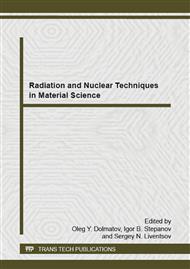p.417
p.422
p.426
p.430
p.434
p.438
p.443
p.447
p.451
Possibility of Using Nuclear Track Membrane for Ophthalmology
Abstract:
This work is devoted to study the possibility of using a nuclear track membrane for ophthalmology in epithelial-endothelial corneal dystrophy treatment. Experiments were conducted using the track membrane “TOMTREK” based on polyethylenterephthalate (PET) with pores diameters (0.2-0.8)micron and (5x106-2x109) pores/cm2 density. The pores were formed by irradiating the polymer PET 40Ar+8 ions with energy 41.5 MeV. After irradiation, the membrane was chemically treated in the alkaline solution. Imparting hydrorhilicity membrane was the next step. Contact angle of the wettability the surface track membrane was measured just after the chemical treatment in NaOH and after 10 hours in air. The surface had been processed by the plasma self-sustained volume discharge to give the surface the hydrorhilic properties of the membrane. The maximum voltage on plasma discharge was 20-22 kV. The energy density in the discharge was 6·10-4 J/cm2 per pulse. Pulse repetition rate was 103 s-1. Samples of 6x6 cm were attached in a special rotating device. Thus, the effects were both surfaces of the membrane. After surface treatment, TM samples were placed in plastic bags. After a night contact angle of wetting was measured with these samples. Disks treating by the plasma were cut. The disk’s diameter was 6-8 cm. The edges of the disks were incised and processed with hot temperature in order to obtain the model of an appropriate shape. It was a shape of a truncated sphere with a certain radius of curvature. Then, the membrane was sterilized and implanted into the anterior chamber of the pig’s eye. Thus, we tested the methods of barrier keratoplasty using the nuclear track membrane.
Info:
Periodical:
Pages:
434-437
Citation:
Online since:
January 2015
Authors:
Keywords:
Price:
Сopyright:
© 2015 Trans Tech Publications Ltd. All Rights Reserved
Share:
Citation:


